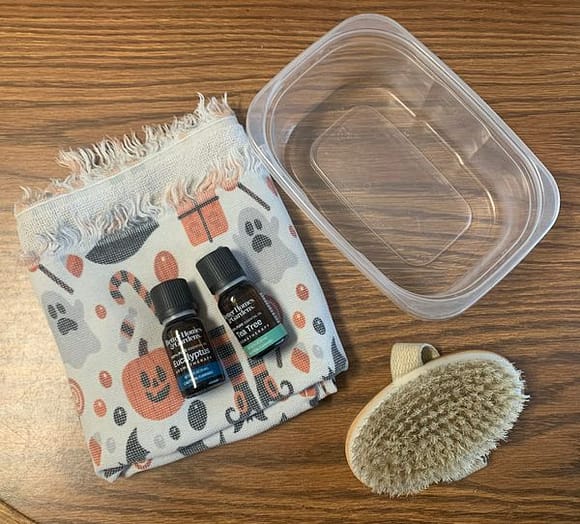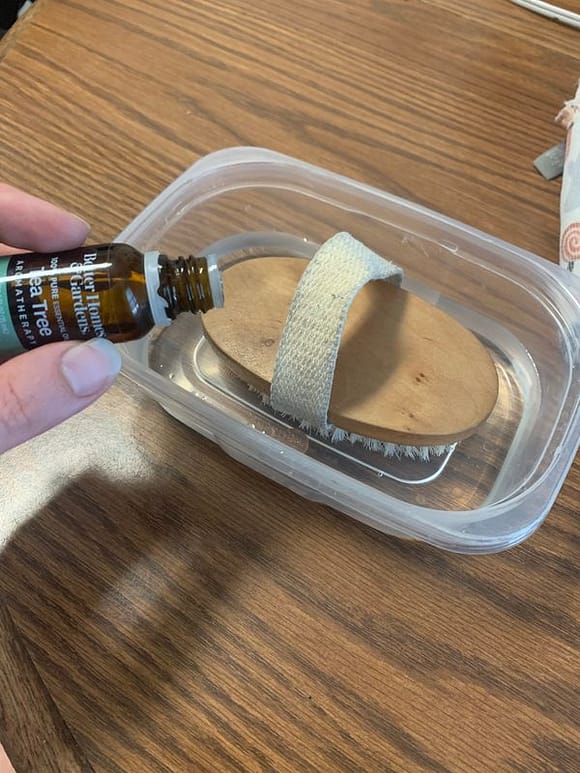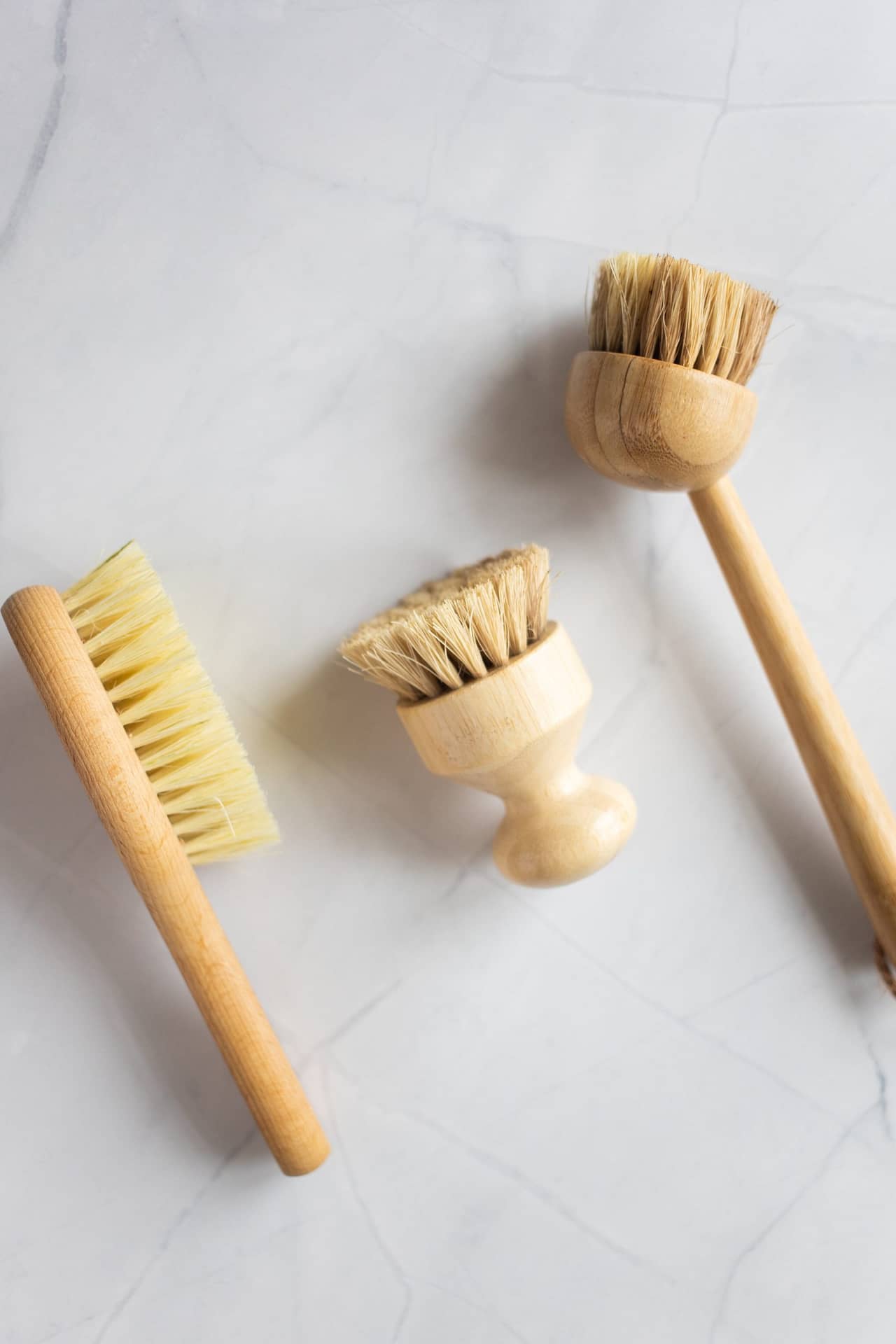If you have a dry brush, maybe you already know it needs a good cleaning every now and then.
You know – from all that rub rub that gets the blood flow going.
(Oh, okay, so your mind is in the gutter too)
Or maybe you’ve never even thought to clean your dry brush.
Oops?
Whatever camp you’re in, you must learn how to clean your dry brush so it – and your skin – stays as healthy as possible.
So how do you clean a dry brush, and how often should you do it?
Plus, can you disinfect your dry brush between washings?
Here’s a step-by-step guide on properly cleaning and disinfecting your dry body brush.
You’ll learn 3 different methods and how often you should clean your dry brush.
You can also make a disinfecting spray to keep your dry brush clean in between brushings.
But first, you should better understand why taking care of your dry brush is a good idea.
So let’s briefly brush up on that.
Do you have to wash your dry brush?
Yes, you do have to wash your dry brush every once in a while to prevent dead skin buildup.
This page contains affiliate links, and I earn a small commission if you make a purchase through one of the links at no cost to you. As an Amazon Associate, I earn from qualifying purchases. I only recommend products I have personally vetted.
Why should you clean your dry brush?
You should clean your dry brush because the bristles and wooden base collect your dead skin cells, bacteria, dirt, and oils.
With regular dry brushing, this gunk builds up and, if not cleaned regularly, can cause acne or irritated skin.
Sounds lovely right?
But luckily, it’s not hard or time-consuming to give your dry brush a good cleansing, and it doesn’t take much to make a simple cleaning solution either.
There’s a recipe for a dry brush disinfectant spray below.
What do you need to clean a dry brush?
Look inside your bathroom closet, and you’ll probably find the few things you need to clean your dry brush:
- small to medium container or dish
- warm water (enough to soak the roots of the bristles but not the wooden base)
- towel
- 1 teaspoon of a gentle cleansing agent like *Dawn, *castile soap, *baby shampoo, or 3-5 drops of an *antimicrobial essential oil (choose one below)
Antimicrobial essential oils help prevent bacteria and other ickies from growing on your dry brush.
Choose from any of these:
- bergamot
- blood orange
- cedarwood
- chamomile
- citronella
- eucalyptus
- lavender
- lemon
- lemongrass
- peppermint
- rosemary
- tea tree

How do you clean a dry brush?
There are 3 ways you can clean a dry brush:
- by deep cleaning and soaking in water and a cleansing agent,
- by giving the dry brush a light cleaning and running it under warm water, and
- by spraying the bristles with a gentle disinfectant spray.
If you’re in a pinch (like you stumbled upon this article and thought, oh shit, I didn’t know I’m supposed to do this), then you can do the light cleaning method as soon as you’re done reading this blog post.
And don’t worry if you’re wondering how to clean a dry brush without tea tree oil or other essential oils.
Using the oils is optional in all 3 cleaning methods.
Still, they add antimicrobial properties that help prevent bacterial growth.
Deep cleaning method
It takes about 15 minutes to deep clean a dry brush.
Here’s how to do it:
- Get your bowl and add your choice of cleansing agent.

2. Add the warm water to the bowl. You want to use enough water to cover the entire bristle, but not the dry brush base.
3. Place your dry brush into the container with the bristles face down in the water.

4. Using your hand on the paddle and moving in a gentle circular motion, gently massage the bristles in the water to help loosen up the gunk.

5. Leave the body brush to soak for 5-10 minutes.

6. Take the brush out and give it a little shake, then place the bristles face down on a towel.

7. Pour the water out and rinse your dish, replacing it with the same amount of clean water.
8. Place your dry brush bristle-side down again in the water, massaging the bristles with your hand on the paddle top. Again, use a slow, circular motion to loosen the gunk.
9. Repeat if necessary until the bristles and water are no longer soapy.
10. Take the brush out one more time, bristles down on the towel. You can also put it outside in the sun to dry for 30 minutes to an hour. Keep it out of direct sunlight to avoid fading the wood.
Light cleaning method
The light cleaning method takes 10 seconds, and your toddler could do it:
1. Run the bristles under warm water for 5 seconds, avoiding water touching the base
2. Tap the brush against the side of the sink to remove excess water and skin particles
3. Lay flat to dry on a towel, bristles face down
How to disinfect a dry brush
If you want your dry brush to be extra clean, you can disinfect the bristles and base with a homemade cleaning spray.

To make the disinfectant, you need:
- 3-5 drops of *eucalyptus oil
- 3-5 drops of tea tree oil
- 2 cups distilled water
- 1 cup vinegar
- Spray bottle
Vinegar is antibacterial, so using this spray after every use will help keep your brush long-lasting and fresh.
If you don’t have eucalyptus, you can also use lavender or any of the essential oils from the list above.

To disinfect, spray your dry brush with 1-2 spritzes, though avoid directly spraying the base.
Instead, hold the dry brush away from you, turn it, and mist the bristles.
Give it a shake then let it dry for at least 30 minutes face down on a towel (it takes about half an hour for vinegar to work its magic).
I like to do it over the sink or in the shower.

How often should you clean your dry brush?
If you dry brush every day, deep clean your dry brush once a week.
If you reach for it less than that, once every two weeks is fine.
How often should you disinfect a dry brush?
You should disinfect your dry brush with an antimicrobial cleaning solution in between uses.
No worries, though, if you don’t – it’s just an extra cleanly step!
Your takeaway
Dry brushing is a fantastic way to massage off dead skin and increase your blood flow.
But with all that brushing comes routine cleaning if you want to keep the bristles and base in tip-top shape.
You can use the light cleaning method to quickly rinse off the bristles between uses and spray them with a diy antimicrobial disinfectant.
For a deeper clean, soak the bristles in water with a cleansing agent for a few minutes, let it dry, and you’re good to go.
What dry brush do you use, and how often do you clean it?

